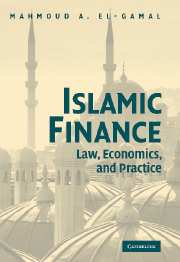Book contents
- Frontmatter
- Contents
- List of Illustrations
- Preface
- Glossary and Transliteration
- 1 Introduction
- 2 Jurisprudence and Arbitrage
- 3 Two Major Prohibitions: Riba and Gharar
- 4 Sale-Based Islamic Finance
- 5 Derivative-Like Sales: Salam, Istisna', and 'Urbun
- 6 Leasing, Securitization, and Sukuk
- 7 Partnerships and Equity Investment
- 8 Islamic Financial Institutions
- 9 Governance and Regulatory Solutions in Mutuality
- 10 Beyond Shari'a Arbitrage
- Conclusion
- Notes
- Bibliography
- Index
6 - Leasing, Securitization, and Sukuk
Published online by Cambridge University Press: 06 July 2010
- Frontmatter
- Contents
- List of Illustrations
- Preface
- Glossary and Transliteration
- 1 Introduction
- 2 Jurisprudence and Arbitrage
- 3 Two Major Prohibitions: Riba and Gharar
- 4 Sale-Based Islamic Finance
- 5 Derivative-Like Sales: Salam, Istisna', and 'Urbun
- 6 Leasing, Securitization, and Sukuk
- 7 Partnerships and Equity Investment
- 8 Islamic Financial Institutions
- 9 Governance and Regulatory Solutions in Mutuality
- 10 Beyond Shari'a Arbitrage
- Conclusion
- Notes
- Bibliography
- Index
Summary
In recent years leasing has become increasingly popular as a vehicle for financing the purchase of various assets, as well as issuance of various financial instruments, from mortgage-backed securities to bond structures known as sukuk. The increased popularity of lease-based financing and securitization stems from the existence of underlying physical assets, the usufruct of which is being transferred under various leases or subleases. Those underlying assets ostensibly allow secondary markets for lease-based debt instruments to emerge, without violating the general prohibition of trading in debts to which most schools of jurisprudence adhere (with the notable exception of Malaysian jurists following a particular opinion within the Shafiʿi school). As we shall see later in the chapter, various jurists apply the physical-asset-backing interpretation of contemporary Islamic financial instruments with varying degrees of strictness.
General Lease Conditions
Retired Justice M. Taqi Usmani – one of the foremost leaders in Islamic finance, chairing multiple Shariʿa boards – argued that the sale of a lease-backed security transfers material ownership rights and obligations from one lessor to another, and hence the purchaser of such a security is entitled to collect rent thereof. Needless to say, conventional asset-backed securities, whether lease or sale based, are often merely financial claims, with little material distinction between the two. Thus, commenting on common legal structures of lease-backed securities, Justice Usmani wrote:
It should be remembered, however, that the certificate must represent ownership of an undivided part of the asset with all its rights and obligations. […]
- Type
- Chapter
- Information
- Islamic FinanceLaw, Economics, and Practice, pp. 97 - 116Publisher: Cambridge University PressPrint publication year: 2006



